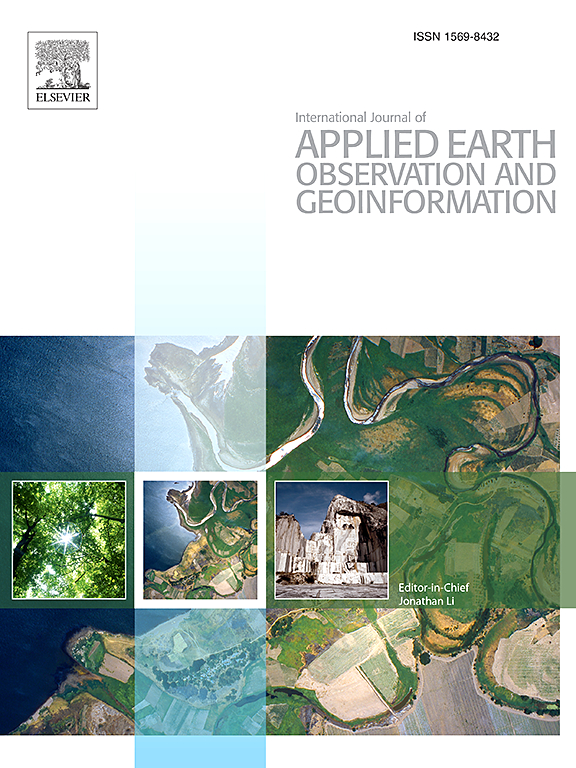无人机影像与气象数据协同精确估算冬小麦穗粒数
IF 7.6
Q1 REMOTE SENSING
International journal of applied earth observation and geoinformation : ITC journal
Pub Date : 2025-02-01
DOI:10.1016/j.jag.2024.104320
引用次数: 0
摘要
快速、准确、无损地估算冬小麦每穗粒数(GNPP)对加快智慧育种、提高作物精准管理水平、保障粮食安全具有重要意义。作为3个常用产量要素中的2个要素(单位地面积穗数和GNPP), GNPP的遥感量化效果远不如目测量化。地面冠层光谱的精度较低,近穗成像系统的效率较低。没有关于使用无人机(UAV)图像估计GNPP的研究报道,强调其在高分辨率和高效监测方面的强大优势。为了解决这些问题,本研究提出了一种将无人机图像和气象数据结合元学习集成回归估算冬小麦GNPP的实用方法。研究了光谱指数(SIs)、最佳冠层高度(CH)度量和吸收光合有效辐射(APAR)等不同变量对GNPP光谱估算的潜在贡献。本文章由计算机程序翻译,如有差异,请以英文原文为准。
Accurate estimation of grain number per panicle in winter wheat by synergistic use of UAV imagery and meteorological data
Rapid, accurate, and nondestructive estimation of grain number per panicle (GNPP) in winter wheat is crucial to accelerate smart breeding, improve precision crop management, and ensure food security. As two (panicle number per unit ground area and GNPP) of three commonly used yield components, GNPP was much less quantified with remotely sensed data than the former through visual counting. The limited research suffered from either low accuracies with ground canopy spectra or low efficiency with proximal panicle imaging systems. No studies have been reported on estimating GNPP with unmanned aerial vehicle (UAV) imagery, underscoring its strong advantages in high-resolution and efficient monitoring. To address these issues, this study proposed a practical approach for estimating GNPP in winter wheat by integrating UAV imagery and meteorological data with meta-learning ensemble regression. The potential contributions of different variables were examined for understanding the improvement in the spectral estimation of GNPP, including spectral indices (SIs), the optimal canopy height (CH) metric, and absorbed photosynthetic active radiation (APAR).
The results demonstrated that CHP99 (CH at the 99th percentile in the region of interest) derived from red-green-blue (RGB) imagery exhibited the strongest correlation with measured plant height among all RGB- or multispectral (MS)-derived CH metrics. The incorporation of remotely sensed APAR and RGB-derived CHP99 improved the accuracy of GNPP estimation over using merely color indices or SIs. Among all feature combinations, Comb. #6 (SIs + APARMS + CHP99) yielded the highest overall accuracies in estimating GNPP for individual and multiple stages. Compared with the best anthesis models for Combs. #5–7 (Rval2 = 0.52–0.64, RMSE = 2.85–2.47, RRMSE = 6.01–5.21 %), the multi-stage (heading + anthesis) models exhibited higher accuracies in independent validation (Rval2 = 0.60–0.65, RMSE = 2.60–2.42, RRMSE = 5.48–5.10 %). The findings suggest this study has opened a new avenue for estimating GNPP with UAV remote sensing. The proposed method for the synergistic use of UAV imagery and meteorological data has great potential in the prediction of GNPP and grain yield over various regions with satellite imagery and climate datasets.
求助全文
通过发布文献求助,成功后即可免费获取论文全文。
去求助
来源期刊

International journal of applied earth observation and geoinformation : ITC journal
Global and Planetary Change, Management, Monitoring, Policy and Law, Earth-Surface Processes, Computers in Earth Sciences
CiteScore
12.00
自引率
0.00%
发文量
0
审稿时长
77 days
期刊介绍:
The International Journal of Applied Earth Observation and Geoinformation publishes original papers that utilize earth observation data for natural resource and environmental inventory and management. These data primarily originate from remote sensing platforms, including satellites and aircraft, supplemented by surface and subsurface measurements. Addressing natural resources such as forests, agricultural land, soils, and water, as well as environmental concerns like biodiversity, land degradation, and hazards, the journal explores conceptual and data-driven approaches. It covers geoinformation themes like capturing, databasing, visualization, interpretation, data quality, and spatial uncertainty.
 求助内容:
求助内容: 应助结果提醒方式:
应助结果提醒方式:


